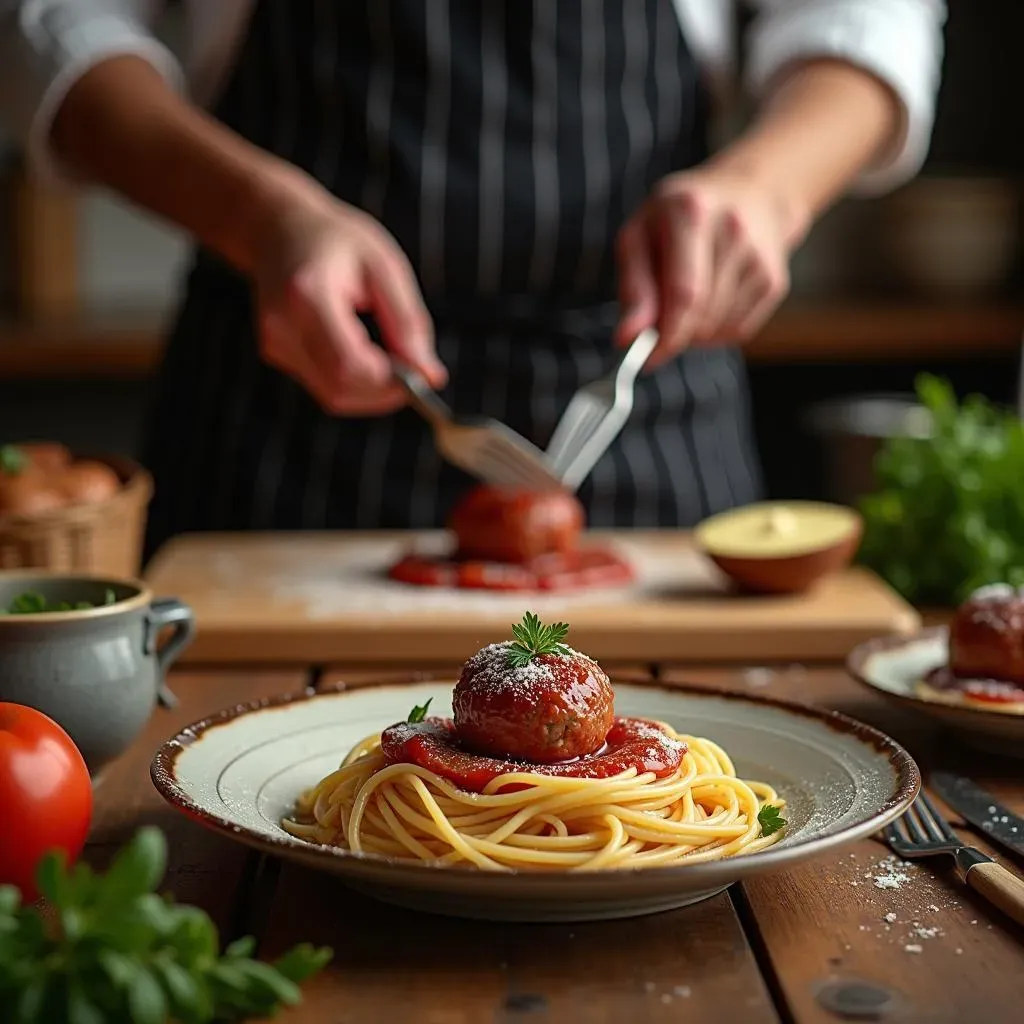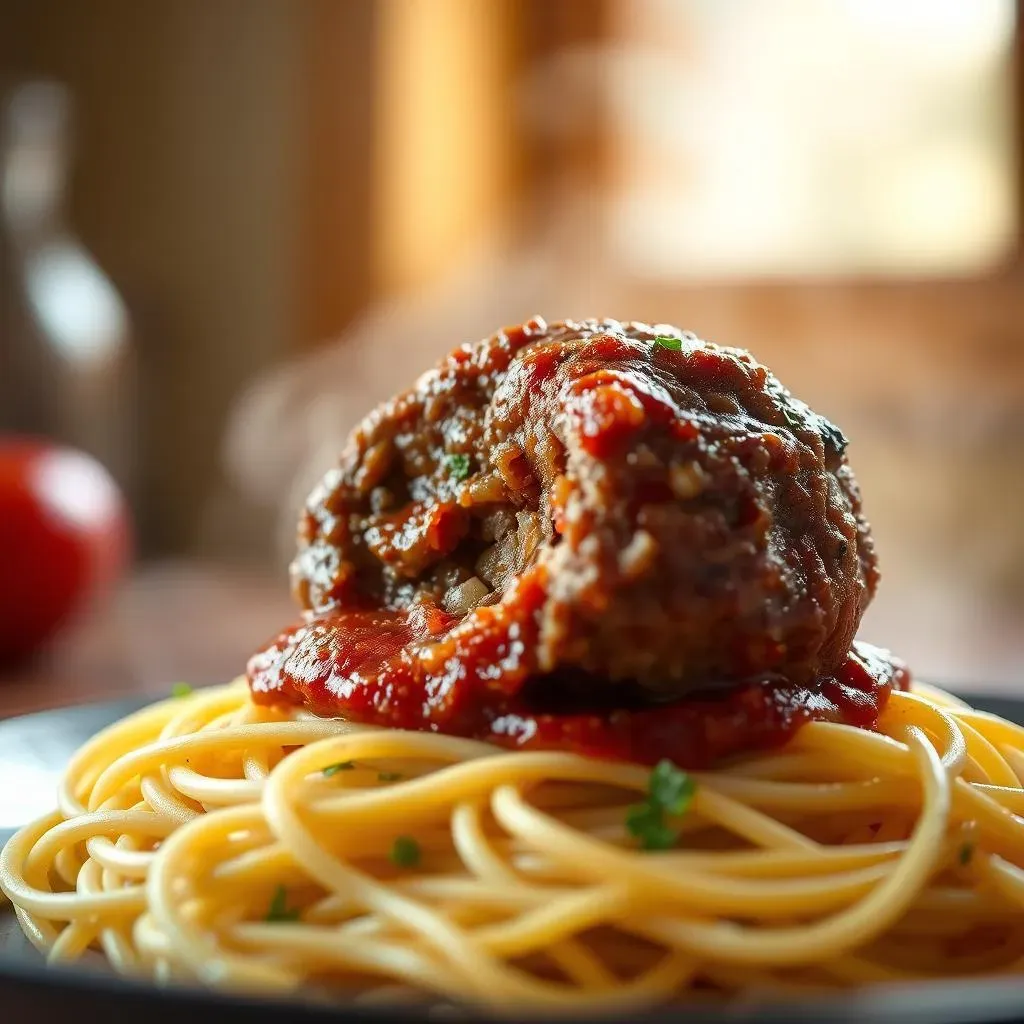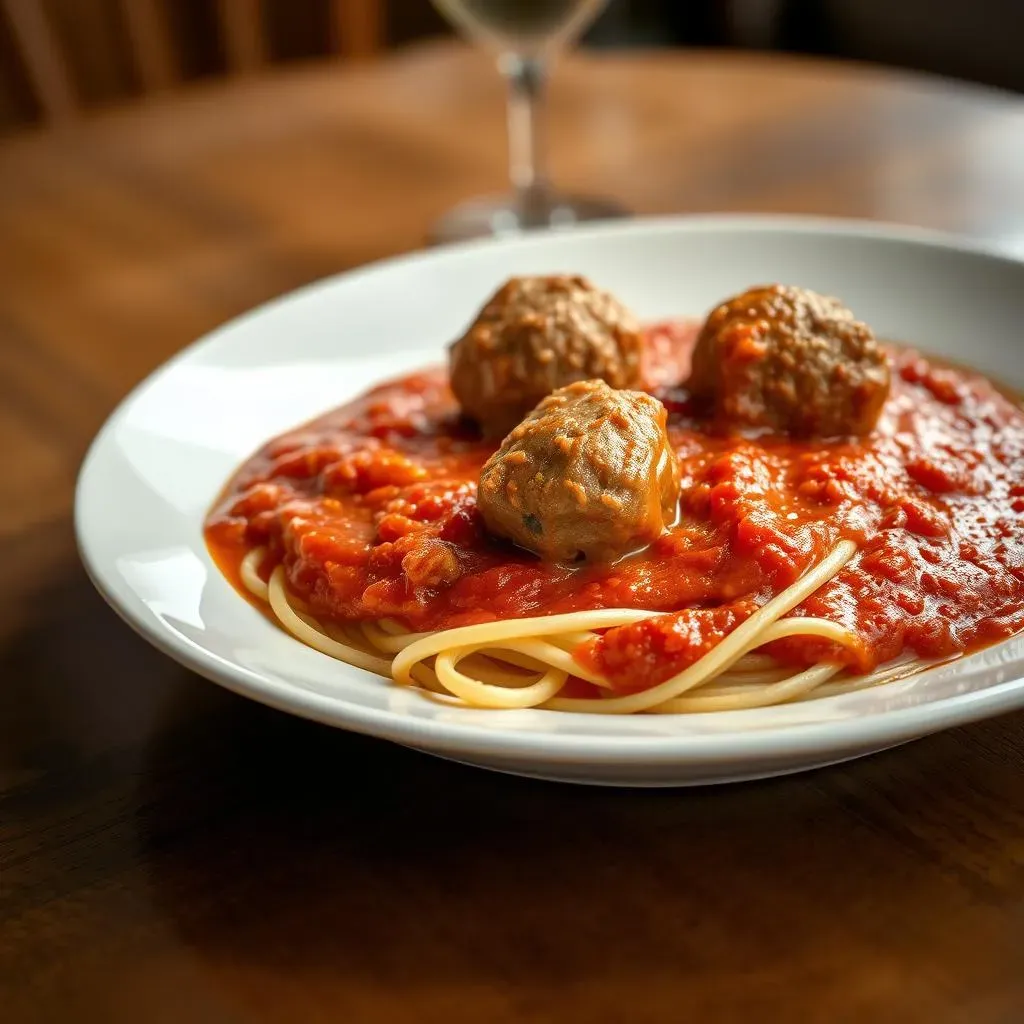Table of Contents
Ready to elevate your spaghetti night? Forget those dry, bland meatballs! This article is your passport to creating the ultimate beef meatball recipe for spaghetti – juicy, flavorful, and utterly irresistible. We'll walk you through every step, from crafting the perfect meatball mixture to mastering a rich and delicious spaghetti sauce. You'll discover the secrets to achieving perfectly tender meatballs bursting with flavor, techniques to prevent them from becoming dry and tough, and even some handy tips for serving up your culinary masterpiece. Get ready to impress your family and friends with a spaghetti dinner that's truly unforgettable. This isn't just a recipe; it's a journey into the heart of Italian-American comfort food, a celebration of simple ingredients transformed into something truly special. So, grab your apron, gather your ingredients, and let's get cooking! By the end, you'll be a beef meatball spaghetti master.
Crafting the Perfect Beef Meatballs for Spaghetti

Crafting the Perfect Beef Meatballs for Spaghetti
Choosing Your Beef: The Foundation of Flavor
Let's start with the star of the show: the beef! For truly juicy meatballs, I recommend using a blend of ground beef – a mix of lean and fattier cuts works wonders. Think of it like this: the lean beef provides the protein structure, while the fat adds moisture and richness, preventing those dreaded dry meatballs. Aim for around 80/20 lean-to-fat ratio for optimal results. Don't be afraid to experiment! You can even try adding a little ground pork for extra flavor and moisture, as our beef and pork meatballs recipe shows.
A good quality ground beef is key. Think about the flavor you want. A slightly richer, more intense flavor? Maybe a leaner option for a lighter meatball? It’s your choice! Once you've chosen your beef, make sure it's properly chilled before you start mixing everything together. This helps prevent the fat from melting too quickly, leading to a better meatball texture. And remember, fresh ingredients always taste better!
Beef Type | Fat Content | Meatball Texture |
|---|---|---|
80/20 | 20% Fat | Juicy and flavorful |
90/10 | 10% Fat | Leaner, but may be drier |
Binding Agents: The Secret to Meatball Cohesion
Next up: the binding agents! These aren't just there to hold the meatballs together; they also add moisture and texture. Breadcrumbs are a classic choice, absorbing excess moisture and creating a tender crumb. However, don't overdo it, or you'll end up with dense meatballs. A little grated Parmesan cheese adds a salty, umami punch and further helps bind the mixture. And don't forget the egg! It acts as a natural binder, holding everything together beautifully. For a truly authentic taste, try using a good quality Italian bread for your breadcrumbs. Need a quick recipe? Check out our quick beef meatball recipe.
Some people like to add herbs and spices at this stage – feel free to experiment! Fresh herbs like parsley and oregano add brightness, while garlic and onion powder add depth. Remember, less is more when it comes to spices. You can always add more later, but you can't take it away! A little goes a long way, especially when using strong spices like black pepper or red pepper flakes. The goal is to enhance the flavor of the beef, not to overpower it.
Mixing and Shaping: The Art of the Meatball
Now for the fun part: mixing and shaping! Gently combine all your ingredients in a large bowl. Don't overmix – you want the meatballs to be tender, not tough. Overmixing develops the gluten in the meat, resulting in tougher meatballs. Once everything is combined, use your hands to form small, evenly sized meatballs. Aim for about 1.5 to 2 inches in diameter. Consistency is key here; it ensures even cooking.
Before you cook them, consider lightly browning the meatballs in a skillet. This adds a beautiful depth of flavor and creates a nice crust. Or, you can skip this step and bake them directly. Both methods work great! If baking, arrange them on a baking sheet lined with parchment paper. This prevents sticking and makes cleanup a breeze. For a different twist, try our beef meatball sliders recipe. They're perfect for a party or a quick weeknight meal!
- Gently mix ingredients.
- Form 1.5-2 inch meatballs.
- Lightly brown (optional) or bake.
The Secret to Juicy and Flavorful Beef Meatballs

The Secret to Juicy and Flavorful Beef Meatballs
Understanding Fat Content: The Key to Juiciness
Let's talk fat! It's not the enemy; it's your secret weapon against dry meatballs. The fat in the ground beef renders during cooking, basting the meatballs from the inside out and keeping them incredibly moist. That's why a blend of lean and fattier cuts is ideal. Think of it like a perfectly marbled steak – the fat intermingles with the lean meat, creating a symphony of flavor and texture. Our beef-only meatball recipe highlights this perfectly.
Don't be afraid to experiment with different fat percentages. An 80/20 blend is a great starting point, offering a good balance of juiciness and leanness. However, if you prefer a richer, more decadent meatball, you could even go for a 70/30 blend. The key is to find the sweet spot that satisfies your palate. Remember, the goal is a tender, flavorful meatball that melts in your mouth, not a dry, crumbly disappointment. And don't forget the power of good quality ingredients! A superior cut of beef will make all the difference.
Fat Percentage | Resulting Meatball |
|---|---|
80/20 | Well-balanced, juicy, and flavorful. |
70/30 | Rich and decadent, but potentially slightly greasier. |
90/10 | Leaner, but may be drier. |
Cooking Methods: Gentle Handling for Maximum Tenderness
How you cook your meatballs significantly impacts their tenderness. Avoid high heat, which can cause the outside to cook too quickly before the inside is done, resulting in dryness. Instead, opt for gentle cooking methods like baking or simmering in a low-heat sauce. Baking ensures even cooking throughout, while simmering allows the meatballs to gently absorb the flavors of the sauce, resulting in a succulent and flavorful final product. For a different approach, try our beef meatball pasta recipe which utilizes both baking and simmering.
Overcooking is the biggest enemy of a juicy meatball. Use a meat thermometer to ensure they reach an internal temperature of 160°F (71°C) – this guarantees they're cooked through without being dry. Remember, it's better to slightly undercook them than to overcook them. You can always add a few more minutes if needed, but you can't undo overcooking. A little patience and attention to detail will reward you with perfectly juicy and flavorful meatballs, ready to be the star of your spaghetti dinner. Want a simple approach? Check out our simple beef meatball recipe.
- Bake at 350°F (175°C) until cooked through.
- Simmer gently in sauce until heated.
- Use a meat thermometer to check for doneness.
Mastering the Spaghetti Sauce: A Beef Meatball Recipe Companion

Mastering the Spaghetti Sauce: A Beef Meatball Recipe Companion
Building Flavor: The Base of Your Sauce
The sauce is just as crucial as those amazing meatballs! A simple yet flavorful tomato sauce is the perfect complement. Start with high-quality canned crushed tomatoes – they're convenient and often offer a more consistent flavor than fresh tomatoes. Don't be afraid to experiment with different brands until you find your favorite. A good quality olive oil forms the base of your sauce, adding richness and depth. Sauté some finely minced garlic and onion in the oil; this builds a foundation of savory deliciousness. You can also add some herbs at this stage, like fresh basil or oregano, to enhance the flavor profile of your sauce. For an extra boost of flavor, try adding a pinch of red pepper flakes for a touch of heat.
Simmering is key to developing a rich, complex flavor. Low and slow is the way to go here. Let the sauce gently simmer for at least 30 minutes, allowing the flavors to meld and deepen. Stir occasionally to prevent sticking. Taste the sauce as it simmers, and adjust the seasoning as needed. A little salt and pepper go a long way. For a more robust sauce, try adding a splash of red wine or a spoonful of tomato paste. For a quick and easy sauce, check out our Spaghetti and Beef Meatballs Recipe.
Ingredient | Purpose |
|---|---|
Crushed Tomatoes | Adds body and acidity |
Olive Oil | Provides richness and flavor |
Garlic & Onion | Savory base notes |
Enhancing the Sauce: Herbs, Spices, and More
Now it’s time to get creative! Herbs and spices are your secret weapons for transforming a simple tomato sauce into a culinary masterpiece. Fresh herbs, such as basil, oregano, and parsley, add brightness and freshness. Dried herbs also work well, but use them sparingly. A pinch of red pepper flakes adds a subtle kick, while a bay leaf adds depth and complexity. Don't be afraid to experiment with different combinations to find your perfect flavor profile. Remember, taste as you go and adjust the seasoning to your preference. A little goes a long way, especially with strong spices.
Consider adding other ingredients to enhance your sauce, such as a splash of red wine for depth, a spoonful of sugar to balance the acidity, or even a touch of balsamic vinegar for a tangy twist. These additions can elevate your sauce from good to extraordinary. Adding some cooked vegetables, such as finely diced carrots or celery, can add a subtle sweetness and complexity to your sauce. Once you've achieved your desired flavor, let the sauce simmer for a bit longer to allow all the flavors to meld. Our Italian Beef Meatballs Recipe offers a great example of a flavorful sauce.
- Fresh Basil
- Dried Oregano
- Red Pepper Flakes (optional)
- Bay Leaf (optional)
Serving Up Your Delicious Beef Meatball Spaghetti: Tips and Tricks
Pasta Perfection: Cooking Your Spaghetti Just Right
Let's talk spaghetti! Don't overcook it – nobody likes mushy noodles. Follow the package directions, but aim for *al dente* – firm to the bite. This is crucial; it ensures your pasta holds its shape and texture when combined with the rich sauce and juicy meatballs. Remember, you can always cook it a little longer, but you can't undo overcooking! Drain the pasta well, reserving some of the starchy cooking water. This starchy water is surprisingly useful; it helps create a creamy sauce, coating the pasta beautifully.
Once your pasta is cooked, toss it immediately with the sauce and meatballs. This prevents the pasta from sticking together. The heat from the sauce and meatballs will continue to cook the pasta slightly, ensuring it's perfectly cooked through without becoming overcooked. For a richer sauce, add a little of the reserved pasta water to thin it out as needed. You want the sauce to coat each strand of pasta evenly, creating a harmonious blend of flavors and textures. Want a quicker way to make your pasta? Try our quick beef meatball recipe which pairs well with quick-cooking pasta.
Cooking Time | Pasta Texture |
|---|---|
Undercooked | Too firm, crunchy |
Al Dente | Firm to the bite, perfect texture |
Overcooked | Mushy, sticky |
Presentation and Serving: The Finishing Touches
Now for the fun part – plating your masterpiece! A simple, elegant presentation can elevate your spaghetti and meatballs from a weeknight dinner to a special occasion meal. Serve the spaghetti in a shallow bowl, allowing the vibrant colors of the sauce and the golden-brown meatballs to shine. Garnish with freshly grated Parmesan cheese, a sprinkle of fresh basil, or a drizzle of high-quality olive oil. These simple touches add visual appeal and enhance the overall dining experience. For extra pizzazz, consider adding a side of crusty bread to soak up the delicious sauce!
Don't forget about the ambiance! Set the table nicely, light some candles, and put on some music to create a warm and inviting atmosphere. This creates a memorable experience for you and your guests. Whether it's a family dinner or a casual get-together with friends, a little effort in presentation makes all the difference. Remember, it's not just about the food; it's about the experience. Looking for something a bit different? Check out our beef meatball sliders recipe—perfect for a fun twist!
- Use a shallow bowl for serving.
- Garnish with Parmesan cheese and fresh basil.
- Serve with crusty bread.